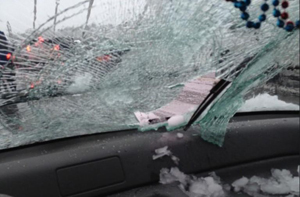
"Ice bombs" dropping onto users of the recently opened Port Mann Bridge and causing it to be closed are just the latest reason to question the entire Gateway plan and how it was executed.
The new Port Mann Bridge is the largest and most expensive bridge in Canada.
It was built in conjunction with the $1 billion (and rising) South Fraser Perimeter Road, a 37-kilometre goods movement corridor along the south side of the Fraser River.
The two do not connect where they intersect, causing a 14 km detour via 176 Street in order to reach the new Port Mann bridge deck.
The South Fraser Perimeter Road construction contract was awarded to a consortium of companies called the Fraser Transportation Group. It was a $659 million fixed price, public-private partnership, and it was to provide the design and build as well as maintenance for a period of 20 years.
In a 2010 press release it was praised by the provincial transportation minister, stating, "The agreement with Fraser Transportation Group represents the major contract for implementing the project and it provides excellent value for taxpayer dollars."
News reports as early as October 2010 had the project already over budget and behind schedule.
An important land bridge at 176 Street and Highway 1 has now been identified as a future add on, leaving a severe grade.
A controversial decision to delay the construction of two important interchanges at Sunbury and Tilbury in Delta has prompted concerns from the trucking industry as well as from the Delta Chamber of Commerce. The latter's transportation chair John Appleby stated recently, "A $1 billion parking lot comes to mind."
David Turbitt of the Delta Chamber of Commerce transportation committee recently projected that the cost of this delay will have a societal cost of $10 million a year in additional fuel costs, lost productivity, and vehicular accidents.
Truck traffic mess
Up to 85 per cent of goods moving through New Westminster, from the southwest corridor, are destined for the northeast side of Highway 1.
TransLink's modelling had predicted that truck traffic from the southeast sector currently using the Pattullo bridge will avoid the Pattullo bridge and take the lengthy detour to the tolled Port Mann.
The distanced travelled from Surrey at the Pattullo bridge and using the Pattullo bridge into the northeast corridor is 9 km. From the same starting point and using the new Port Mann crossing, the distance is 23 km.
Using the new Port Mann crossing by a combination truck would cost out like this: toll $9 and additional fuel needed (at 39 litres per 100 km) $7, for a cost of $16 per trip. This would also produce an additional 14 kilograms of greenhouse gas emissions.
In a 2010 press release, the B.C. transportation minister stated, "The South Fraser Perimeter Road will remove trucks and regional traffic from community streets and put them back on the highway, where they belong."
Yet without a direct connection to the New Port Mann, it appears to be doing just the opposite.
Drivers avoiding tolls
Toll diversion is already evident, yet only half of the South Fraser Perimeter Road is operational.
The full route is projected to open in late 2013, around the same time as the full Port Mann toll comes into effect.
TransLink had stated previously that a direct connection at Port Mann was not possible. Yet a 2001 Ministry of Transportation study evaluated a more direct connection at Port Mann as a viable option. The report cited congestion at the Port Mann bridgehead as a negating factor for this route.
Back in 2001, before the new Port Mann crossing had been announced, a fair re-evaluation of this connection may have produced a different result.
Considering that combination trucks produce 2.6 kg of CO2 per litre of diesel burned, real considerations of greenhouse gas emissions caused by the different connections and interchanges should have played a greater role in the design of this infrastructure.
Building a goods movement highway with traffic lights and a 14 km roundabout detour will not serve anyone well. ![]()
Read more: Transportation














Tyee Commenting Guidelines
Comments that violate guidelines risk being deleted, and violations may result in a temporary or permanent user ban. Maintain the spirit of good conversation to stay in the discussion.
*Please note The Tyee is not a forum for spreading misinformation about COVID-19, denying its existence or minimizing its risk to public health.
Do:
Do not: